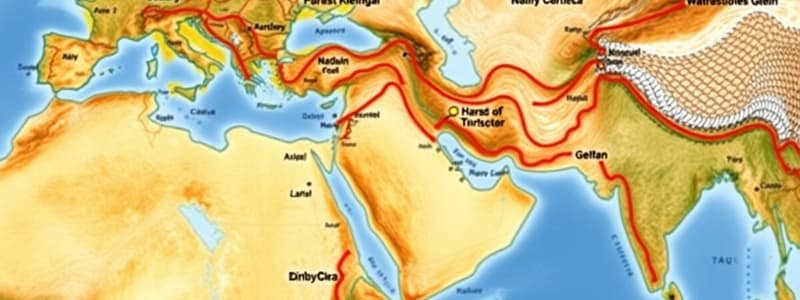Podcast
Questions and Answers
What are Ravenstein's 11 Laws of Migration?
What are Ravenstein's 11 Laws of Migration?
Laws that describe the reasons why immigrants typically move, the distance they move, and their characteristics.
What is Ravenstein's 1st Law of Migration?
What is Ravenstein's 1st Law of Migration?
The majority of people who migrate only travel a short distance.
What is Ravenstein's 2nd Law of Migration?
What is Ravenstein's 2nd Law of Migration?
Migration proceeds in steps.
What does Ravenstein's 3rd Law of Migration state?
What does Ravenstein's 3rd Law of Migration state?
What is Ravenstein's 4th Law of Migration?
What is Ravenstein's 4th Law of Migration?
What does Ravenstein's 5th Law of Migration indicate?
What does Ravenstein's 5th Law of Migration indicate?
What is stated in Ravenstein's 6th Law of Migration?
What is stated in Ravenstein's 6th Law of Migration?
Who are most migrants according to Ravenstein's 7th Law of Migration?
Who are most migrants according to Ravenstein's 7th Law of Migration?
What does Ravenstein's 8th Law of Migration state?
What does Ravenstein's 8th Law of Migration state?
What does Ravenstein's 9th Law of Migration indicate about migration volume?
What does Ravenstein's 9th Law of Migration indicate about migration volume?
What is the primary cause of migration according to Ravenstein's 10th Law of Migration?
What is the primary cause of migration according to Ravenstein's 10th Law of Migration?
What does Ravenstein's 11th Law of Migration say about women's migration patterns?
What does Ravenstein's 11th Law of Migration say about women's migration patterns?
Flashcards are hidden until you start studying
Study Notes
Ravenstein's 11 Laws of Migration
- Laws established to explain patterns and characteristics of migration.
- Address reasons for migration, distances traveled, and demographics of migrants.
1st Law of Migration
- Most individuals who migrate tend to do so over short distances.
- Concept of "Friction of Distance" highlights the decreases in likelihood of long-distance moves.
2nd Law of Migration
- Migration often occurs in stages or steps, rather than as a single, direct move.
3rd Law of Migration
- Long-distance migrants typically choose destinations in major commercial or industrial hubs.
4th Law of Migration
- Each migration trend generates a corresponding counter-migration, balancing the flows of people.
5th Law of Migration
- Individuals from rural settings have a higher propensity to migrate compared to those living in urban areas.
6th Law of Migration
- Men are more likely to migrate over longer distances than women, highlighting gender differences in migration patterns.
7th Law of Migration
- The majority of migrants tend to be young adult males, with families less frequently moving away from their countries of origin.
8th Law of Migration
- Migration contributes significantly to the growth of large towns, often more so than natural population increase.
9th Law of Migration
- As industries and commerce expand and transportation enhances, migration volumes tend to rise.
10th Law of Migration
- Economic factors are the primary motivators for migration, influencing decisions to relocate.
11th Law of Migration
- Women are more inclined to migrate within their local areas rather than venturing further afield.
Studying That Suits You
Use AI to generate personalized quizzes and flashcards to suit your learning preferences.


